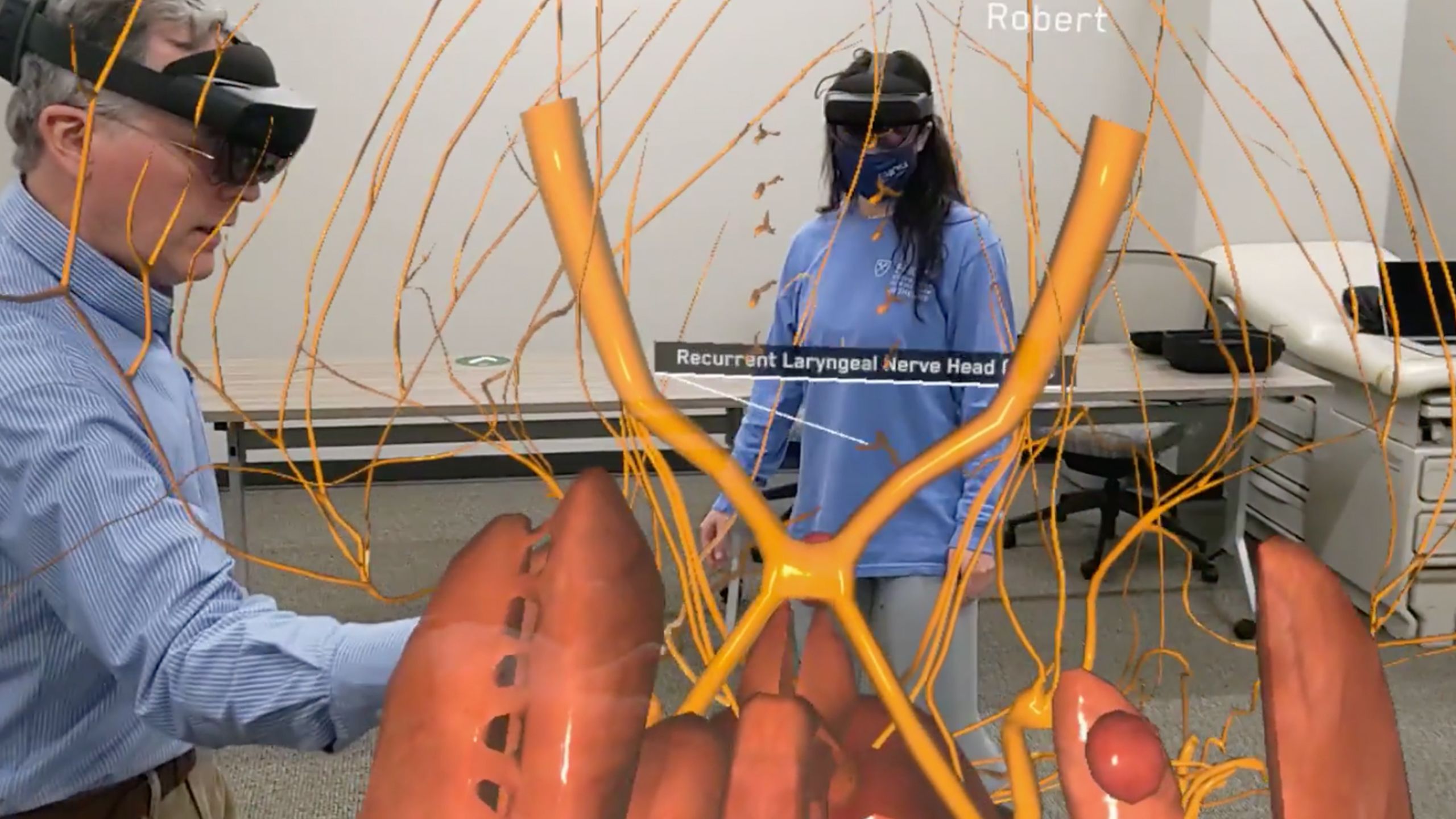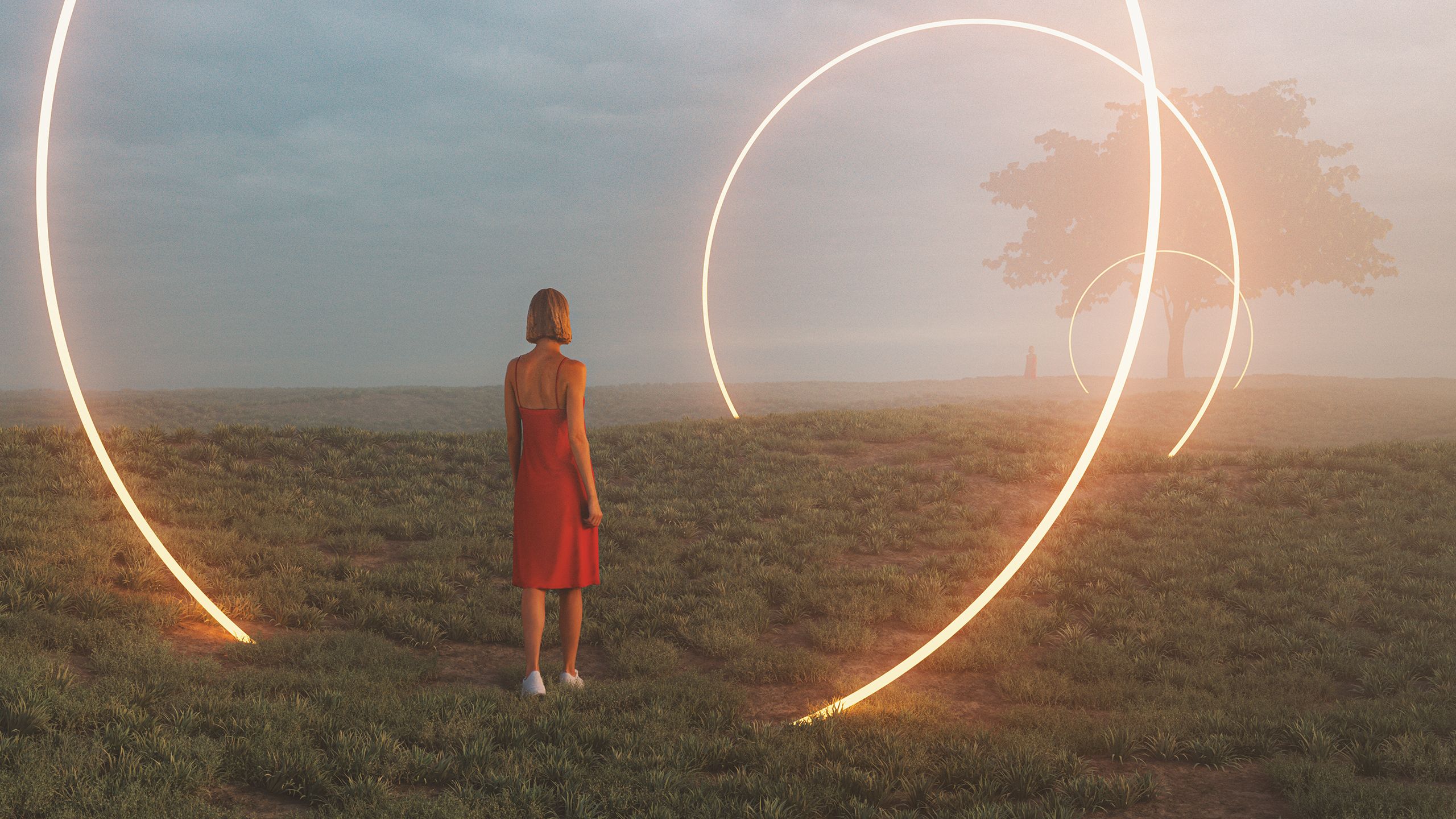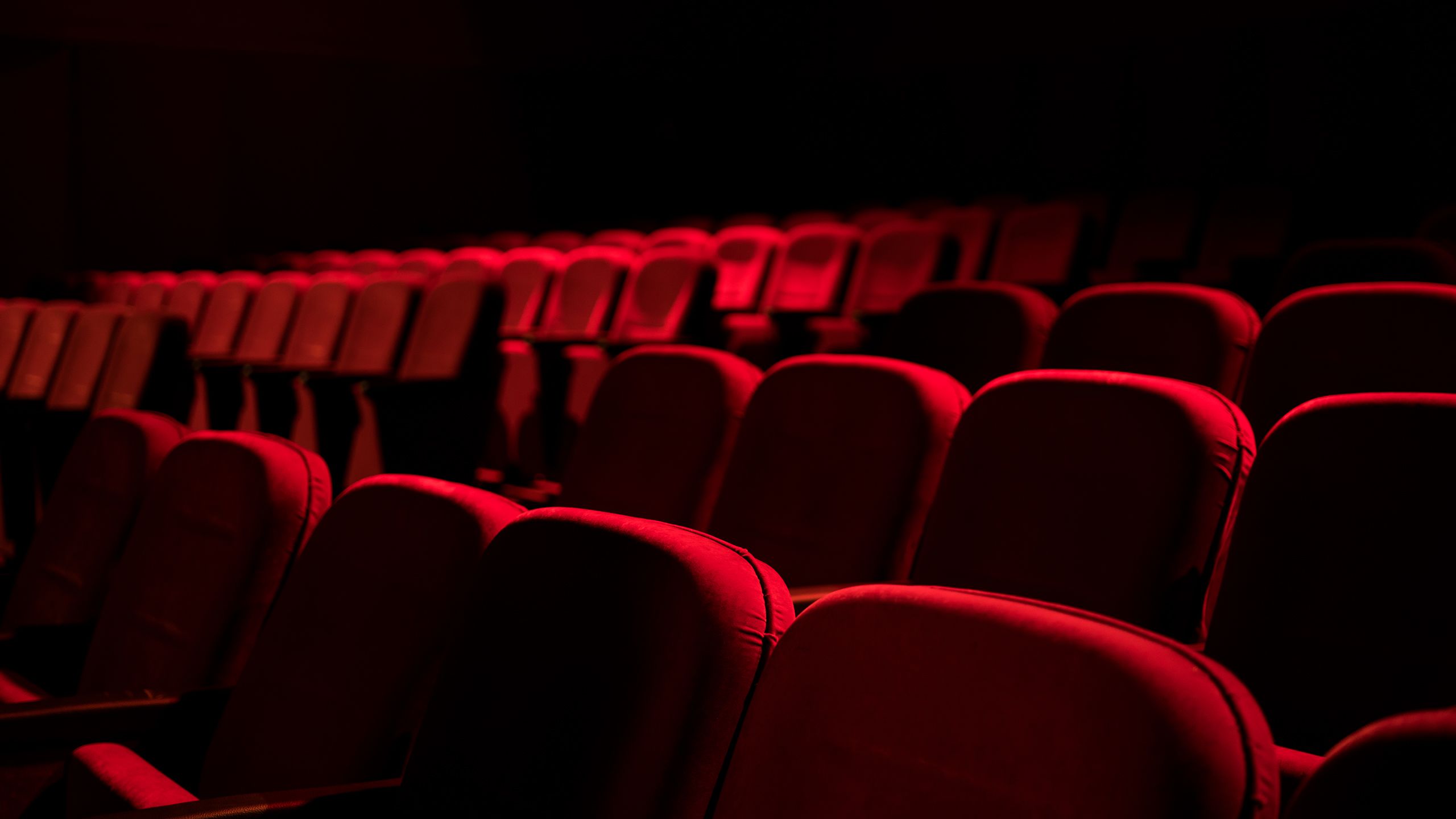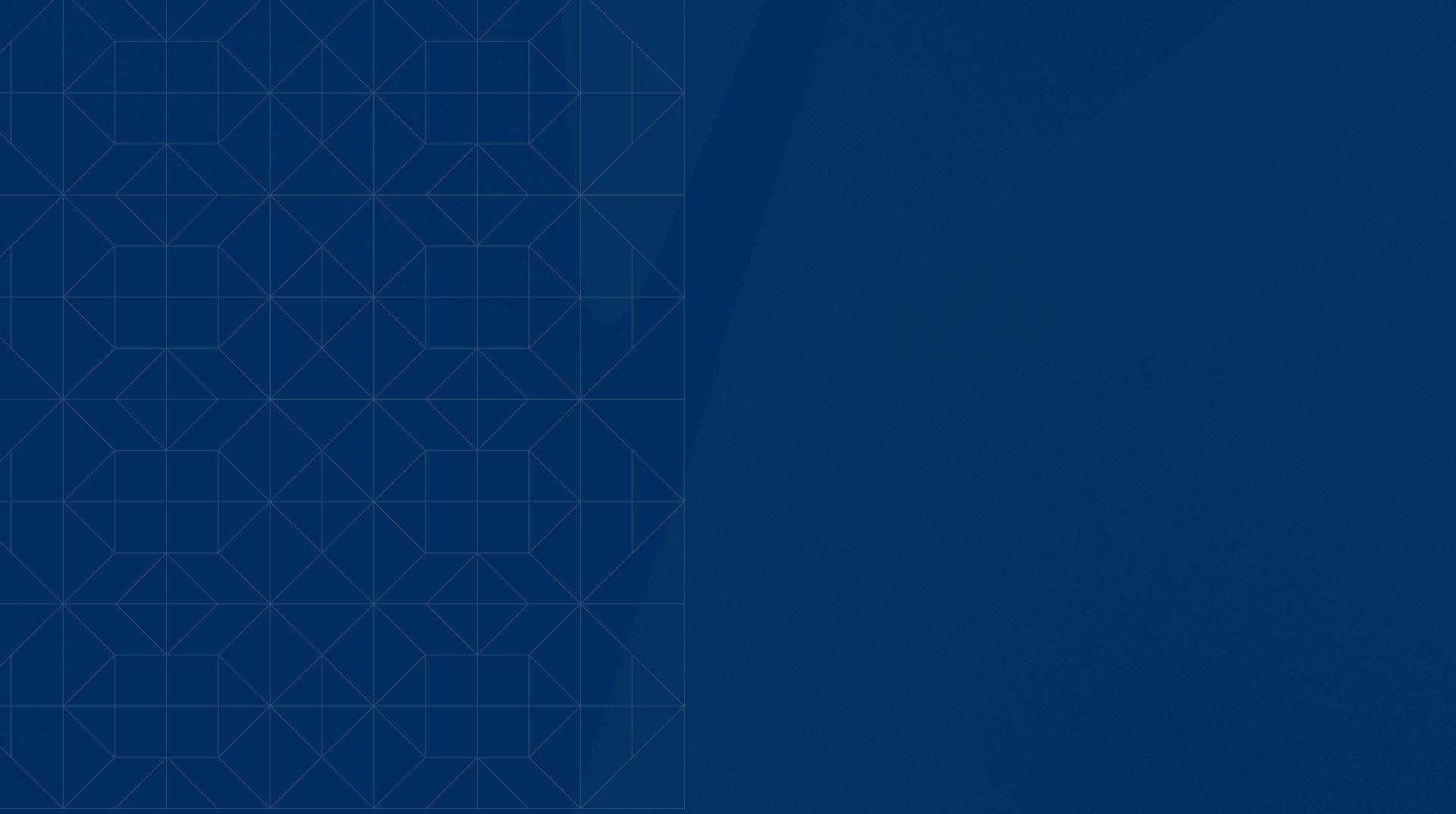THE WAY FORWARD – Education
PIVOT POINTS:
4 EMORY COURSES REINVENTED DURING THE PANDEMIC

With the move to distance learning last spring, Emory faculty had to step back and reevaluate how they taught their in-person classes in online environments such as Zoom.
The unexpected exercise turned out to be a golden opportunity for many, leading to discoveries and innovations that heightened the educational experience for students and teachers alike.
Here are four Emory courses that pivoted to push new boundaries and enacted changes to learning that will remain long after the pandemic has gone.

Dissecting the Human Body, Virtually
COURSE: Anatomy
INSTRUCTOR: Robert McKeon, Associate Professor, Emory School of Medicine
An eight-foot-tall skeleton rises out of the floor, hovering over the paper anchor. The bones are shiny and smooth, with reflective surfaces and shadows adding to the 3D effect. Long wiry nerves, orange as Kraft mac-and-cheese, thread through the bones in intricate tangles. Small gray labels pop up wherever the viewer focuses, denoting things like Sacral Plexus (Left) and Scaphoid (Right). If the user turns their head to either side, panels emerge with buttons to illuminate different organ systems. To an untrained user, the effects of the full-body hologram are almost dizzying.
Robert McKeon has taught anatomy at Emory since 1994. He thinks he’s found the perfect opportunity to bring the anatomy textbook to life during the COVID-19 pandemic and in the years to come—via virtual reality.
Anatomy is one of Emory’s Foundation of Medicine courses, a cornerstone of the first-year curriculum. From November through May each year, 138 medical students participate in a cadaver-based lab class grounded in 15 weekly dissections. The course immerses students in a rich understanding of body systems and their complex interactions.
Before the pandemic, students had unlimited access to the lab. But the pandemic forced several new restrictions and limited students’ hands-on dissecting time. The anatomy lab is now open for eight hours a week—one-half to one-third of the time normally required to complete a dissection. With these restricted hours, efficiency is crucial.
“Our responsibility is to make sure that these students are as equally well prepared to move forward in their professional development as they have been in years past,” says McKeon. “But these guys have to do it with a lot less actual hands-on time. So we’ve got to make better use of it.”
To solve the problem, McKeon has enlisted the help of a new technology that generates an in-depth hologram that can’t replace cadaver dissection but helps students prepare more efficiently for it. While wearing virtual reality goggles called the HoloLens, students can strip away skin, muscles, tendons, and bones from a human-body hologram, revealing an in-depth map of all major organ systems. With a quick finger tap, users can also toggle body parts in and out of place, expand them for a better look, or turn on a color-coded view of the regions.
They can dissect the hologram by pinching and swiping. They can also walk around the body for a 360-degree view, position it supine, prone, or upright, or even peer through the right ventricle for a different view of the tricuspid valve.
“It really is unlike any other technology I have used previously,” explains Denis Ohlstrom, an MD/PhD candidate. “All of the controls were intuitive and I would imagine that most students would be able to freely manipulate models with less than five minutes of training.”
But McKeon emphasizes that the cadavers aren’t going anywhere: The technology is meant to streamline the dissection-preparation process, not replace it. “As good as the HoloLens is, it’s not as good as a cadaver. It’s just not,” he says.
“You know, we learn so much more from working with a cadaver. And not just the anatomy, but the idea of working on another human being. We talk about the cadavers as their first patient. There’s a lot of what we call the hidden curriculum that students get out of just learning about humanity.”
Right now, McKeon only has two sets of HoloLenses, which he uses to broadcast weekly Zoom lectures. He posts the lectures Monday nights, and students watch them in preparation for their cadaver dissections, which are scheduled for Tuesday mornings and Friday afternoons. By helping to better prepare students before they set foot in the lab, McKeon is saving lab time normally reserved for instruction, making dissections more efficient. McKeon estimates that, on average, one hour of HoloLens preparation will save four hours at the dissection table.
He has high hopes for integrating this technology into the curriculum. Ideally, he says, all students would have a HoloLens. Instead of recording predissection lectures on Monday nights, he would lead small groups of students in a virtual, preparatory dissection. The student groups would simultaneously manipulate the holograms in shared sessions. Together, the teams would complete a virtual simulation of the dissection.—Deanna Altomara 20C

Getting High on Multimedia and Guest Speakers Galore
COURSE: Sacred Drugs
INSTRUCTOR: Gary Laderman, Goodrich C. White Professor of American History and Religious Culture, Emory College of Arts and Sciences
Religion professor Gary Laderman’s course Sacred Drugs, explores the ways religion and psychoactive drugs—from coffee to illegal substances—have intersected throughout history and cultures. It is always a popular offering.
In fall 2020, it also happened to be the largest undergraduate course at Emory that was taught online. With a class of nearly 300 students, pivoting to a fully virtual classroom was, at the very least, “a pedagogical adventure,” says Laderman.
“I really wanted to think big and make the class a spectacle, to make students want to come back each session,” he reflects. “It’s a great topic, easy to keep their attention. But even teaching remotely, I wanted to increase the amount and intensity of engagement with the material. And I knew one way to do that was to break up ‘the monotony of me’ and bring in a wide range of guest speakers.”
Since he’s writing a book on religion and drugs, Laderman already had contacts across the country. It helped that he’s also been teaching online summer courses at Emory for nearly seven years, including a pilot project that reached a global audience.
From a lawyer at the forefront of the legalization of cannabis and psychedelics in Denver to a palliative care doctor who runs a hospice center in San Francisco—in addition to Emory neuroscience and religious studies faculty—speakers Zoomed into his class from around the country.
“They did a spectacular job,” Laderman says. “The ease of dropping in via Zoom makes this so much more manageable and easier on both ends. To arrange it in person would have taken so much coordination for a class of this scale. I’ll absolutely do this again, bringing in people who can speak to the topic from a number of professional perspectives.”
As in past years, the class included lectures, readings, documentary videos, and an Instagram account curated by Laderman and his teaching assistant Elaine Penagos, a graduate student in the Graduate Division of Religion, that shares a lively collection of cartoons, student submissions, and news stories tied to class discussions. Together, the class also “listened to music, explored the prevalence of religion in the profane, and found the sacred in the mundane,” he says.
Even though online learning “was rough on many students,” class participation remained strong. Laderman found the writing assignments that students turned in “overwhelmingly engaging and thoughtful.”
This is from a class evaluation by a senior majoring in business: “On the first day of class, Gary made it clear that it was his full intention to confuse us in every way possible. I found that through the readings and class discussions I was constantly confused—not by the material necessarily, but because the class poked holes in my Midwestern Christian background and made me question a lot of principles that I never questioned growing up. This process is a microcosm for how I want to continue to be curious and be a learner throughout my life.”

Flipping and Gaming: Using Class Time in New Ways
COURSE: Probability and Statistics
INSTRUCTOR: Elena Pesavento, Associate Professor of Economics, Emory College of Arts and Sciences
Faced with students anxious about taking her probability and statistics course, economics professor Elena Pesavento decided to ease the fear factor by bringing some fun into the classroom.
In spring 2020, Pesavento wasn’t teaching, which provided the space to think about transitioning to teaching an online course to 55 students last fall. “Moving content online allowed me to think carefully about learning objectives for my students. How do I deliver what I want them to learn? How can I make the best of teaching online?” she recalls.
During faculty training last summer, she was inspired by a workshop focused on how to use games as a review tool. One of the options, “Poll Everywhere,” is an interactive audience response system that allows faculty to survey students during class to assess point-in-time learning, take attendance, or even “gamify” lessons.
It works like this: Pesavento asks a question and students answer by sending a text via phone or laptop, providing an immediate aggregate response. “Say I want to introduce a new topic, such as the probability that you actually have COVID-19 if you test positive for it. If students provide the wrong answer, they want to know why. Or you can explain a topic then prompt a question, capturing what percentage of the class caught on,” she says.
By posing multiple-choice questions, class responses offer immediate feedback on what concepts students may still need to work on. In the virtual classroom, questions were turned into speed competitions, complete with small prizes and rankings for the fastest or most improved—an idea suggested by her students.
In the past, students have always requested to see more problems and explore more applications during class time. So Pesavento decided to flip the classroom: introducing students to material through prerecorded lectures, then using class time to discuss new ideas and put them into practice.
The verdict? “My students loved it; it was probably one of the best classes I’ve ever had,” she says. “Since I didn’t use class time to lecture, there was more of a chance to meet and talk, and students who were struggling weren’t hidden in the back of the classroom. Meeting through Zoom allowed them to be more proactive about messaging me if they didn’t understand.”
Without the demands of teaching during a pandemic, Pesavento probably wouldn’t have tried a flipped classroom. And while she looks forward to in-person teaching, there are aspects of the experiment that she will absolutely carry forward.
“It definitely gave me the push to try something new,” she says. “Though it was a ton of work—as much as creating a whole separate course—my first time trying this was both utterly exhausting and the best thrill I’ve ever had teaching.”

When the Real World Becomes Your Stage
COURSE: Acting Fundamentals
INSTRUCTOR: Mary Lynn Owen, Atlanta Theater Artist and Theater Arts Lecturer, Emory College of Arts and Sciences and Oxford College
When Mary Lynn Owen teaches acting fundamentals in her beginning theater course, she requires students to connect with each other, through exercises and physical expression, as much as texts and course materials.
Sometimes that means improvising inches apart, choreographing a slow-motion fight scene or flinging imaginary paint around the room. “Theater allows you to use all of yourself—your mind, body, spirit, and imagination,” she says. “I want my classroom to be a safe environment in which students can take those risks. From day one, I try to create a community, an ensemble, and encourage students to try new things—to explore, create, and devise.”
Teaching during a pandemic abruptly changed how she could do that. “Last spring, when we were completely on hold for a couple of weeks, I just rewrote my whole course to accommodate where we were going to be,” she recalls.
For her fall classes, Owen then structured lessons in entirely new ways. Teaching online, she tried to meet students where they lived.
“The first third of the class was encountering the self, which you always have to do as an actor,” she says. “I encouraged students to get out into the natural world, revisit their senses—what they smelled and felt and touched and heard. And I tried to engage their physical strengths, to always get them up out of their chairs and moving around the room, often dancing to music, which they loved.”
Her second module focused on “encountering the other, putting students in scenes they could relate to together. We even staged a fight scene, in which one person would initiate an action, and another would respond to it on their screen, scripting pretend punches, which is hard to do via Zoom,” she laughs.
Her final module challenged students to—safely—encounter the world, through interviewing people close to them. “Following the murder of George Floyd and with a divisive election looming, I found students hungry to bring the real world into the classroom,” Owen says. “I asked them to find two people with very different opinions, to interview each person, and then portray each person back-to-back.”
The results, she said, were amazing. “Students I’m working with now are different than they were a year ago or even last fall. They are exhausted. But they are also visionary. And they are gentle and patient with each other.”
The online experience “has reminded me that relationships are the most important subject I’m teaching,” she says. “I try to see students as the creative, oftentimes struggling and expansive humans they are. Together, we’re trying to do our best—lean on me, challenge me, and I will challenge you. I’ve grown to think of teaching in that way, as an open, shared, exciting conversation.”
And she can’t wait to be together again, renewing that conversation in person.
Photos by Damon Meharg and Getty Images. Art Director: Elizabeth Hautau Karp.

Want to know more?
Please visit Emory Magazine, Emory News Center, and Emory University.

